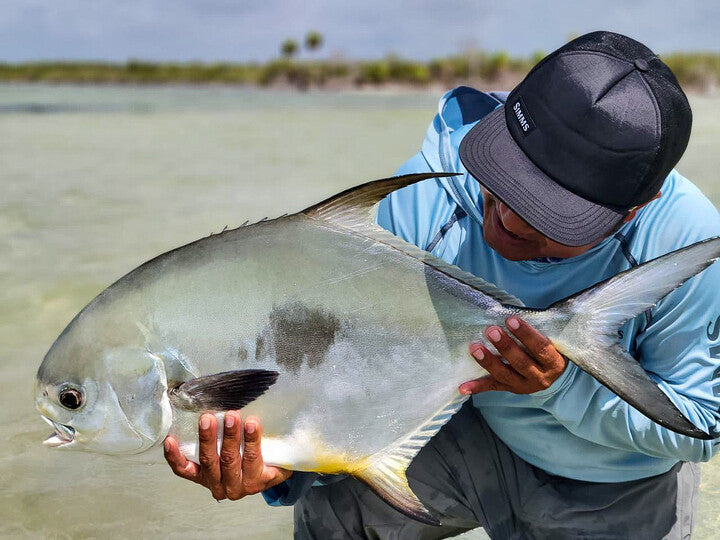Hopper season is in full swing ... Call today to book your Montana Adventure!
Hopper season is in full swing ... Call today to book your Montana Adventure!
Hopper season is in full swing ... Call today to book your Montana Adventure!
Hopper season is in full swing ... Call today to book your Montana Adventure!

November 14, 2022 4 min read
If you've never gone saltwater fly fishing before, this post is for you. Preparing for a saltwater excursion doesn't have to be overwhelming, although it can seem that way. There are a few simple things you need to remember while you're actually on the water, and a few things you can do before you even leave your house. Here are The River's Edge Top 5 Tips for Saltwater Fly Fishing.
One of the most important things you can do before you go saltwater fly fishing is to learn the double haul. This casting technique is nearly essential for most saltwater scenarios. The longer casts and whipping winds mean you need as much line speed as possible in order to make accurate presentations at a distance.
This video from Simon Gawesworth of Rio Products is an excellent introduction to the double haul. The timing can be tricky, and it takes some practice, but if you want to have any sort of success in the salt, the double haul is non-negotiable. The best part is that you can take this technique and use it any time you fish. You'll be surprised at how much it will improve your casting.
One mistake many anglers make when fly fishing the salt is taking too many false casts. Many saltwater fish have very well developed senses, including sight. If you're targeting a school of permit or bonefish, sometimes they will spook simply from seeing the shadow of the line or fly over top of them. You'll make a few false casts thinking "just one more and I'll get it there" and before you know it, you've spooked the entire school without even presenting your fly.
Success in the salt often comes down to making quick, accurate casts. Work on picking up the line and re-casting without false casting. Set up some plates in the yard or a park and try to get near each of them while only picking up the line and laying it back down. Practicing these quick shots will help you immensely.
Unfortunately, fly fishing gear isn't always universal. The saltwater environment is extremely difficult on fly fishing tackle. Rods, reels, and lines get beaten up from the sun, the heat, and the corrosive salt water. While you may want to take your trusty 6-weight trout setup to chase small bonefish, it's not the best idea. Here are some gear tips for your next saltwater adventure:
The sun can absolutely destroy your skin and your eyes while you're on the water. Nothing can ruin a day faster than a bad sunburn or an issue with your eyes. That's why it's imperative that you cover up (either with SPF rated fishing gear or some burly sunscreen) your skin and your eyes. No matter where you are—Cape Cod, Texas, Belize, Florida, the list goes on—having proper sun protection can save the day on the water and prevent any future damage. The Simms SolarFlex Hoody (now 40% off!) is our go-to in the sun. From Montana to Christmas Island and everywhere in between, we've worn our SolarFlexes everywhere.
As for your eyes, wearing a good pair of polarized sunglasses is a must. The sun comes at you from all angles in the salt water: above, sideways, and even from the surface of the water below you. Having a decent amount of coverage will help keep the rays from blasting right into your eyes. The polarization will help you see the fish in the water (which is part of the fun of saltwater fly fishing anyway) and protect you from damaging light.
Many people get intimidated thinking about fly fishing with a guide in the salt. A lot of guides can be intense and excitable, which can come across as demanding or mean. Often, tense exchanges can be avoided by working with your guide as soon as you stop the motor. Talk to the guide about the directions he or she will have you cast. What direction is 12 o'clock to the guide? What about 9 o'clock? Figure this out first, and then talk about distance. Ask the guide to work with you on how far he or she believes each distance is. When they say 40 feet, what does that mean to them? Narrowing down some of these variables can make the experience easier on both of you when the fish show themselves.
DO. NOT. TROUT. SET. Repeat this to yourself as often as possible.
Take a breath, listen to the guide and remember the directions and distances you discussed. Also, relax. It's just fishing. Enjoy yourself!
DO. NOT. TROUT. SET.

April 29, 2024 1 min read